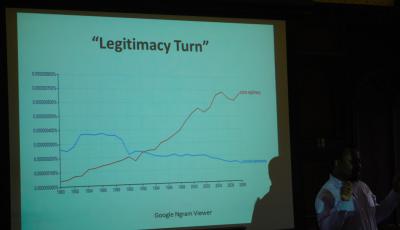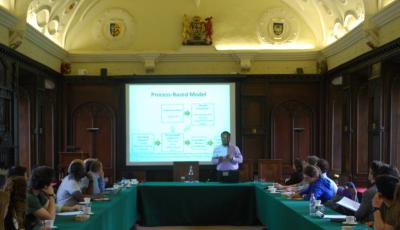n this post, Richard discusses the recent Criminology Seminar, ‘Re-thinking Police Legitimacy,’ delivered by Dr Justice Tankebe of the University of Cambridge on 12 March 2015.
Pointing to the Google Ngram Viewer projected onto the screen hanging alongside the crests that decorate All Souls College’s ancient walls, Dr Justice Tankebe described the ‘legitimacy turn’ that has taken place in the criminal justice literature in recent decades. This turn has been away from criminal deterrence, based on instrumental compliance with a rule or authority, towards legitimacy, where compliance is driven instead by a normative sense of obligation. Tankebe’s aim was to further chart the role of legitimacy in understanding our relations with agents of the criminal justice system and, ultimately, to suggest some adjustments that could steer the scholarship on a course that will improve the conceptualisation of legitimacy.

i) The nature of legitimacy
The seminar was concerned with empirical legitimacy, which is normative in character, but fundamentally distinct from normative legitimacy. The distinction generated some discussion and is worth outlining.
An empirical approach understands legitimacy to be a social fact, expressed in the actions and motivations of individuals and capable of being researched and recorded by social scientists. The normative quality of the empirical is in the positive recognition of the moral right to be in power. This is distinct from normative legitimacy, which is comprised of theorists’ a priori criteria and accounts of authority which institutions or systems must achieve or ‘fit within’ in order to lay a valid claim to this property.
Within the empirical legitimacy camp, the significant and valuable re-thinking that Tankebe (co-developed with Sir Anthony Bottoms) brings to the nature of legitimacy comes in the form of the ‘continuous legitimacy dialogue.’ Legitimacy ought to be understood as an ongoing dialogue, in which power-holders make claims that are received and responded to by one or more audience(s), with the audience response having the potential to alter the power-holder’s future claims.
Reviewing the classic sociological work of Weber and political theory of Coicaud, it quickly becomes apparent that power-holders are part of the legitimacy story, and that they interact with an audience to form a relationship that’s conditional in nature. Yet, these simple but fundamental features acknowledged by Tankebe, which are well known within sociology, have been almost entirely absent in the field of legitimacy cultivated by criminologists. For instance, the research of Tyler and other scholars focused exclusively on the public, without reflecting upon what this audience is responding to and what power-holders are presenting, or think they are presenting, in both substance and form, when making their claims to legitimacy. Such re-thinking by Tankebe enriches the conceptualisation of legitimacy within criminology, opens up new avenues for research―as shown in recent work by Bradford and Quinton and Jonathan-Zamir and Harpaz―and may encourage us to think harder and more critically about the official, and unofficial, claims criminal justice authorities make when exercising their power over citizens and non-citizens.

Another of Tankebe’s central ‘re-thinks’ concerns the way in which legitimacy is measured, and thus defined, in existing quantitative research. Most often, it’s done with the obligation to obey at the core of the measure, with researchers adding their own variants, including trust and/or confidence in, or moral alignment/shared values with, the police. Such approaches, Tankebe asserted, ‘block’ and ‘frustrate’ the conceptual development of legitimacy. According to Tankebe, the variation across studies makes comparisons difficult, while the focus on the obligation to obey fails to sufficiently capture legitimacy’s normative quality, as outlined earlier. He suggested that feelings of an obligation to obey might equally derive from fear or ‘dull compulsion’ to comply.
The proposed answer by Tankebe, it seems, was a definition of legitimacy comprised of four ‘basic legitimation demands,’ drawing on Williams’ term. Referred to as the ‘Bottoms-Tankebe Model,’ the four demands of (1) lawfulness, (2) distributive justice, (3) procedural justice, and (4) effectiveness are what distinguishes a legitimate authority from an illegitimate one. Conducting a ‘legitimacy assessment’ of the NSA and GCHQ controversy around privacy rights using media coverage, Tankebe identified each of the four legitimation demands at issue.
This re-measurement is indeed a re-thinking, but on the merits of this point I’m less convinced. Arguably, combining an obligation to obey with moral alignment or trust and confidence allows researchers to access the normative quality of legitimacy. Of greater concern, however, is the apparent merging of the concept of legitimacy with the conditions of legitimacy, something I will return to below.
Of further interest was Tankebe’s unearthing of the dictionary definition of legitimacy at the beginning of the seminar as ‘the condition of being lawful’ and ‘conforming to a rule or accepted standards.’ Indeed, in the legal arena, legitimacy can mean something closer to the alignment of particular laws with a procedural or substantive conception of the rule of law, for example. Yet, within the body of research on empirical legitimacy, this definition of legitimacy has tended to find form through ‘legality,’ recognised as either part of the definition of legitimacy, as discussed by Bradford and colleagues, for example, or else one of its ‘basic legitimation demands.’ As suggested by a member of audience, this difference in understanding is perhaps a reflection of the focus of criminology on the agents of the law, rather than the law itself.
iii) The conditions of legitimacy
Great energy has been spent by researchers to determine the conditions of legitimacy or ‘basic legitimation demands’―the factors that lead people to believe an authority has this property called legitimacy. The extent of the re-thinking here by Tankebe seems, in actual fact, to be more of an underscoring of key findings in the literature. For instance, the four conditions set out in the Bottoms-Tankebe Model can be found in many pre-existing studies where they are sometimes labelled as perceptions or trust judgments. The question isn’t so much whether these factors are necessary conditions, but rather whether legitimacy as a concept exists separate from them.
During the seminar Tankebe presented a reflective statistical model of legitimacy. Here, there was a latent construct (legitimacy) which was specified as existing independently of measures of it (the four legitimation demands); that is, legitimacy was specified as being something other than the four demands themselves. However, Tankebe’s main argument was precisely the reverse, in that he stressed that legitimacy is comprised of the four demands and has no existence independent of them. Consequently, legitimacy becomes amorphous, lacking an agreed understanding or definition and making the very concept, not just the conditions that produce it, relative to the particular context which is being researched.
iv) The researching of legitimacy
The field of study is largely dominated by quantitative studies, often drawing on large data sets at national and city levels in the United States and Britain. Undoubtedly this has produced a wealth of knowledge and proved successful in identifying levels of police legitimacy―although the focus has been on trust and confidence―and the factors that correlate with such beliefs, the most significant of which is procedural justice. In re-thinking police legitimacy against this quantitative backdrop, Tankebe rightly pointed out that there remains plenty of room for a variety of other methodologies, such as more qualitative research that engages with people to better understand basic legitimation demands in certain contexts at certain times.
A particularly novel approach suggested by Tankebe is the use of official data, citing as an example the US Department of Justice report on Ferguson, perhaps to get a sense of the claims power-holders are making and the extent to which the audience legitimation demands are being heard. A similarly unique contribution to the present scholarship would be longitudinal studies, which Tankebe thought could be used to track the life course of a police organisation and capture the ways that authorities maintain and repair their legitimacy.

Keywords:
Share:
